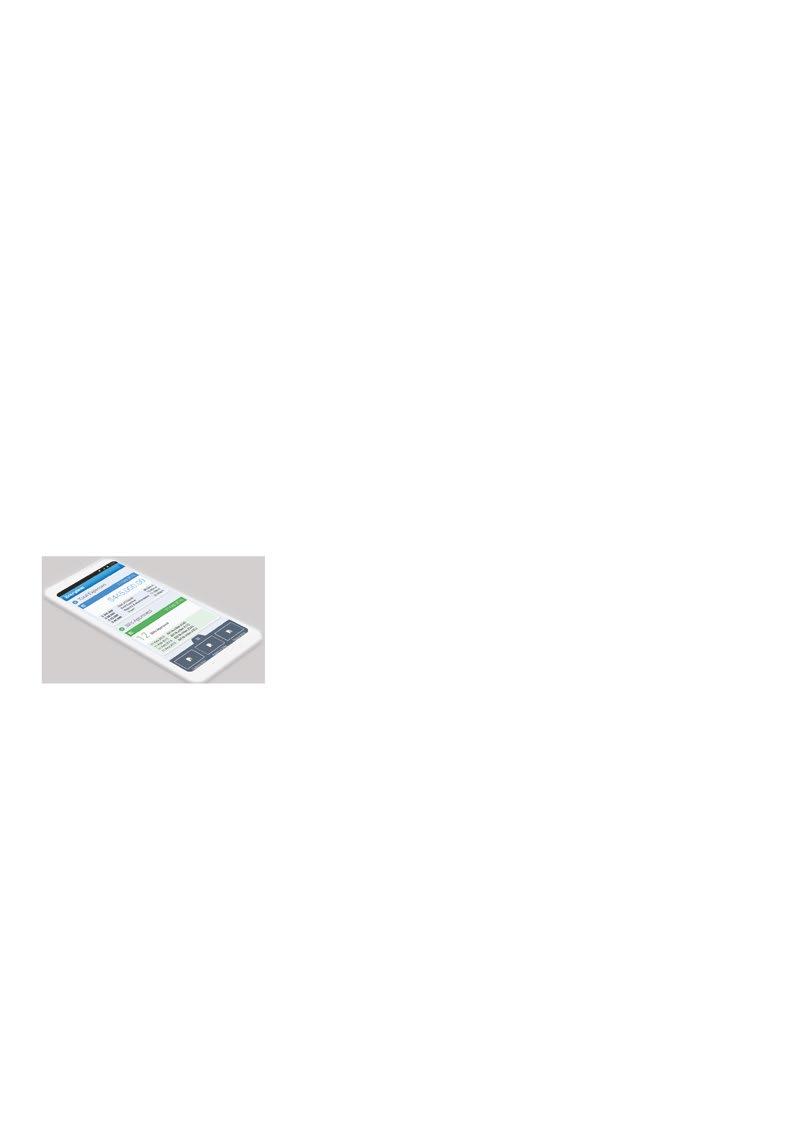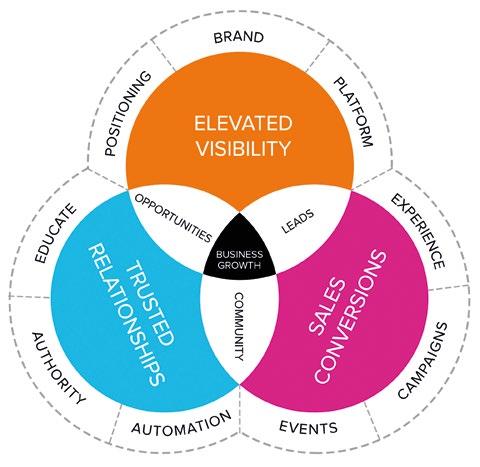
15 minute read
Relationship marketing - How to be remembered
Relationship Marketing How To Be Remembered, Recommended & Referred
When I ask accounting firms how they get their clients, the majority say through referrals. Then I ask them how happy they are with their business growth and they quickly say they want more leads and clients...
@amandacwatts
Amanda Watts, Co-Founder,
TwentyTwo Agency
Amanda inspires leading firms of accountants to use marketing to grow their business. She is the founder of the British Accounting Marketing Awards, TwentyTwo Agency, an Amazon bestselling author, mentor for Virgin Start-Up and creator of the Marketing Implementation Programme – The Pioneering Practice. Amanda’s marketing methodologies enable firms to be visible, vital and valued.
Whilst traditional referral
marketing works, solely relying on it could lead challenges and your firms collapse. Challenges could include:
Trickle Not Flood
Often you are solely reliant on clients and your network referring you only when you come to mind. Traditional referrals therefore tend to come in a trickle.
Feast and Then Famine
Referrals used to come in fast and furious when your network was untapped. However, these leads dry up as your network refers all of their connections.
Technology Advancement
Your services are no longer perceived to be as valuable as they once were. Your services are commoditised. Which means price is being driven down.
Referral Clients No Longer Solely Trust The Referrer
10 years ago a referral was all that was needed when choosing who to work with. There was enough trust.
The referral landscape has changed. Now when someone asks, “Do you know a good accountant” they also visit Google, Facebook and the accountant’s website before they make the first call. The recommendation is only the first stage, rather than the complete stage.
If you can’t rely on referrals what should you be relying on? Is it social media, SEO, blogging, telesales or networking?
There is an overarching strategy that encompasses all of these and more.
Relationship Marketing
If you can purposefully build relationships with prospects, clients and your network - you will grow your profits daily.
Relationship marketing starts:
The moment someone finds your firm on Google. The moment you say “hello” to someone at a networking event. The moment they see a Tweet from you. The moment you have the first telephone conversation.
First impression, first interaction, first thought. Relationship marketing is NOT just about building relationships with current clients. It is about building relationships with influencers, prospects, clients and your network.
Let me talk you through the strategy for achieving excellent relationship marketing.
1. ELEVATED VISIBILITY
If you do not purposely make yourself visible you will only get a trickle of leads.
To have elevated visibility work on these areas:
Positioning
You need to understand who your ideal clients are. We suggest having a specialism or niche. By focusing on a certain kind of client it will be easier to know the problems and solutions around your client’s pain.
Who do you help – Solicitors, Plumbers, Hairdressers… chose a niche or two and become known as the go-to accountant for that niche.
This will instantly de-commoditise your services and you will not be driven down on price.
Brand
Automate Bill Entry and Payments.






















Get 30% OFF! Use Coupon Code: XUMAGAZINE
about you when you are not in the room. You need to craft your image to ensure clients and your network are proud to promote you, and that prospects are attracted to you.
Platform
You need to be seen in the right places by the right people. By focusing on the platforms that your ideal prospect is on you free up time and money. You will send out a more targeted message and build deeper relationships.
2. TRUSTED RELATIONSHIPS
Trust is the true definition of a great relationship. Firms are now able to build trust with prospects and build a network before ever speaking to them.
“57% of the buyer’s journey is completed before ever speaking to sales” – Hubspot
Educate
People are asking questions every day in Google. You can answer them using content marketing. Through

Authority
Social proof builds trust and authority. Whether you use case studies and testimonials or have won awards/have key industry players shouting about you, you need to show your authority.
Automation
This process may seem timeconsuming compared to traditional referral marketing. Whilst you are required to do some of the work, you can leverage your time. Online scheduling and marketing tools are available to help you. Examples include scheduling tools like Buffer and Hootsuite. As well as marketing automation there are tools available to automate the tasks you carry out when you are serving your clients. An example of this is Xero’s automated accounts payable. This takes care of time-consuming admin, frees up your personal time, and gives you more time to build relationships with clients and prospects. Whilst visibility and building relationships are essential for lead generation, you need to convert those leads into evangelical clients. Traditionally this was done with lengthy 2-hour meetings and no guarantee that you would get the client. This need not be the case anymore.
Events
How many of you are sitting in these lengthy meetings? By using events to present your insights you will reach many people at one time. One of our clients runs quarterly events around Property Tax. He gets 50 people in a room and from that he gets clients, builds his network, strengthens relationships and elevates his brand.
Campaigns
Well executed marketing campaigns raise awareness, create excitement and fill events. Rhythmic quarterly campaigns will ensure that your marketing is not scattergun, but focused and effective.
Experience
From the experience of an event or meeting, all the way through to onboarding a new client. Every experience with a prospect, client or your network should exceed their expectations creating evangelists that sing your praises, attracting even more clients and referrals. Great tools for this include Xero, Practice Ignition, GoProposal and MyFirmsApp to name a few. If you focus on providing an excellent experience for your clients you will own that relationship and they will not shop around.
So, whilst other firms are still relying on traditional referral marketing, or are playing at social media and blogging, you will be different. You will be elevating your visibility, building trusted relationships and having leveraged sales conversions, ensuring sustainable business growth.



5 steps to great

@CAforecasting
Michael Ford, Co-Founder and CEO, Castaway Forecasting
Michael is a specialist in the financial and strategic aspects of running and growing successful businesses. He is both a Chartered Accountant and a CPA and brings more than 30 years’ experience across a range of disciplines and industries. Michael is an entrepreneur and thought leader on growing businesses. In the last 20 years, he has founded a series of successful businesses, including Castaway Forecasting.
cashflow forecasting
Small business cashflow is a
roller coaster of income and expenses as the annual seasons progress. The same cashflow cycles show up year after year, yet we continually see businesses falling into the same cashflow hole.
The good news is that there is a better way!
A well-prepared cashflow forecast is an early warning system that lets you spot signs of cash trouble months, or even years in advance. Importantly, it provides the time and space for you to take action early to avoid a cash crunch.
The bad news is that good cashflow forecasting requires hard work up front from the person who knows the business best – you.
You can’t expect to throw together forecast in minutes. It takes effort, but it’s worthwhile to provide you with clarity about your business future.
So what does it take?
Fortunately, software tools like Castaway Forecasting make it easy to prepare your cashflow forecast the right way. Castaway looks after the calculations, freeing you up to focus on getting the assumptions right.
The goal when building a cashflow forecast is for your model to reflect reality as closely as possible. The more realistic the model, the more reliable the outcomes.
To help you get there, I’ve boiled down the 5 principles of building a great cashflow forecast:
1. 3-way (integrated) is powerful and best-practice
are properly calculated, bestpractice is to prepare a 3-way, or integrated, forecast. This is a special type of model that combines forecasts for all 3 basic financial reports for a business - the Profit & Loss, the Balance Sheet and the Cashflow Statement.
Banks love 3-way forecasts, because they know the cashflow numbers have ‘accounting integrity’. 3-Way forecasts also provide a great sanity check to ensure you haven’t missed anything in your forecast workings.
Although it may sound a robust spreadsheet cashflow
complicated at first, the idea is that you forecast the Profit & Loss Statement (revenues, expenses, taxes and dividends) and the Balance Sheet (assets, liabilities and equity).
‘fall out’ of movements in the 2 reports. If the Profit & Loss numbers are realistic and the movements in the Balance Sheet seem sensible, the cashflow you might enter £1,000 for
forecast, by definition, will also make sense.
2.Set specific cashflow attributes for every line
In reality, the cashflow pattern for, say, your Electricity Expenses line will be different to the cashflow pattern for Staff Wages, or Rent, or Stock Purchases. Electricity Expenses might be paid quarterly, Staff Wages might have, say 70% of the cost being paid in the current month with 30% being held back to be sent to the tax collector next month. Rent might be paid one month first method is more attractive.
in advance and Stock Purchases might involve a 30% deposit up front, with the other 70% paid 30 days after the goods are received.
A good forecast will reflect these differences by using a separate set of cashflow attributes for every line. This means a little but you already know the characteristics of your income and expenses and the increase in accuracy is worth it.
3. Build a dynamic model using operations drivers
When putting a forecast together,

you will often face a choice between entering static numbers or building the numbers up from the underlying operations drivers.
Consider these two alternative approaches…
If you decided to enter static numbers, (the first approach), revenue, £600 for Cost of Goods Sold and £1,200 for Closing Inventory.
If you instead worked from drivers (the second approach), you might enter sales as 50 units being sold at £20 each. Cost of Goods Sold would be set as 60% of sales and you would hold 60 days of Closing Inventory.
Both methods will show the same results on the Profit & Loss and the Balance Sheet, so you might think the simplicity of the more time setting up the forecast,
However, when it comes time to update the forecast, you will find the second approach far more useful.
Let’s say business has been good and you want to increase your sales forecast by 10%. In the first approach, you would need to work out the new sales, COGS and inventory figures and then enter them into the forecast manually. In the second, more dynamic approach, you only need to change the sales units (up to 55 in this example). The forecast will then automatically update the sales revenue, COGS and Closing Inventory numbers.
4.If it’s not up to date, it’s out of date
In business, the only constant is that things change. Customers come and go. Prices and margins change. The business environment changes. As the world changes around your business, it is important that your cashflow forecast changes to match it.
We encourage our clients to review the forecast often (at least monthly) and update it where necessary so that it always reflects the ‘best view of the future’. An out of date forecast is at best misleading and at worst dangerous as a basis for making business decisions.
5. Play with different scenarios
As economic times become more uncertain, our approach to forecasting needs to become more sophisticated.
Once you have a robust cashflow forecast in place, don’t stop there. Create several copies of the model and test the cashflow impact of different scenarios – it could be general sales growth or decline, gaining or losing specific customers, taking on new product lines, buying new assets, or whatever is on your mind.
Remember, the point of forecasting is not to try to predict the future perfectly. Rather, it is about working out what the future would look like if a given set of assumptions were to take place and then figuring out a game plan to deal with the situation.
FIND OUT MORE...
To find out more about Castaway Forecasting please visit our website: castawayforecasting.com
That’s a wrap!
Accounting Business Expo, 2018 is a wrap. And as Mr Samaranch would have said, the vendor-neutral, independent showcase was Australia’s biggest and best ever. (Thanks Juan, cheque’s in the mail.)
The first thing you would
have noticed when you arrived at this year’s expo would have been the sheer scale – significally bigger than 2017. Packed out seminar theatres, a sea of impressive exhibitors, and with close to 4,500 professionals in attendance the expo floor was nothing short of vibrant.
Visitors returning from last year spotted a couple of welcome surprises. The coffee was free – and so was the water, along with loads of great spots to hang out and take a break.
The hit of the expo was the new matchmaking facilitly. (No, it wasn’t Tinder, settle down.) It was a much more efficient way to canvass all suppliers in any category, and to facilitiate deeper and more meaningful connections amongst the audience. Thinking about adding advisory? Or trying to decide which expense management tool to use? Instead of waiting at a stand to grab a salesperson you just book an appointment online before the show, swan in at the appointed hour and then let rip.
Thousands of attendees pingponged their way through the expo floor, getting answers to all their questions without wasting a minute of their time. Think of the billable hours saved!
It wasn’t just meetings with suppliers. I saw plenty of groups gathering in the expo cafe, lounge area and bars outside. Bookkeepers, accountants and CFOs from all walks catching up, sharing their thoughts on the best suppliers and talking about the plans for their own businesses.

@AccountingBExpo
Sholto Macpherson is head of content for the Accounting Business Expo and editor of accounting technology blog
DigitalFirst.com
Some had travelled hundreds of kilometres to join in the fun.
One of the happiest sights for me was the session theatres packed to the rafters. This year we added wireless headsets that blocked out the ambient noise so you could hear everything happening on stage creating a unique silent disco feel to the event.
The BT and FUTRLI theatres pulled strong crowds, particularly to the more practical sessions. “How I won a $100k p.a. client in one meeting”, “How to turn a $3k client into $12k”, and “How an accountant became a growth strategist – with six-figure clients” were each firsthand accounts of practitioners sharing stories of success with their peers.
Tim Reed and Trent Innes from
MYOB and Xero respectively talked about the impact of technology on business and the accounting industry. Jo Burston from Job Capital pulled no punches in her advice to the audience on what SMEs want from their accountant, demonstrating the drive that took her to $40 million revenue in five years.
And the youthful Damien Singh spoke about the joys and travails of running the finances for Australia’s second tech unicorn, Canva.
The first Accounting Business Expo exploded onto the scene in 2017 and took a lot of people by surprise. This year the show matured quickly into the anchor that the industry sorely needed.
Thank you to everyone who made it all those who missed it, the magic returns in March next year. I hope to
down to Darling Harbour, Sydney. To see you there.


Save the Date Accounting Business Expo 20 - 21 March 2019 ICC Sydney Exhibition Centre, Darling Harbour, Sydney










